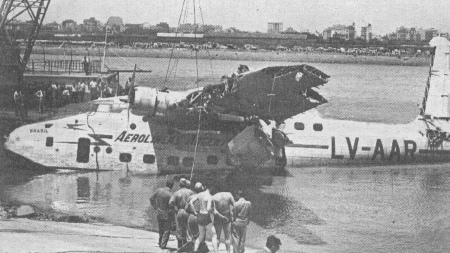Submersion of an Aerolíneas Argentinas seaplane into the Río de La Plata on December 31, 1957 in the old hydroport of the City of Buenos Aires, which caused the death of nine people and activated a rescue that managed to save more than thirtyled to the deactivation of the “water tracks” that functioned for the regular air transport of passengers.
The aircraft had taken off at 11:52 a.m. on a scheduled international flight to Asunciónwith stopovers planned in the Argentine cities of Rosario, Corrientes and Formosa, detailed the final report of the accident produced by the Civil Aviation Accident Investigation Board (Jiacc).
minutes after noon, the commander of the “Brasil” seaplane, registration LV-AAR and Sandringham model, Miguel Albero, which carried 44 passengers and a crew of six peopledecided to return due to technical problems, but the landing area had already been occupied by a ship in transit.
After 30 minutes of overflight awaiting clearance, it was decided to “dock” in another sector of the river where the waters were more “choppy”, something that “apparently” caused the LV-AAR to bounce several times in the water, lose a float and one of its engines, to then fall on its nose and “partially sink”according to aviation specialist Marcelo Miranda.
In November 1988, Miranda published a series of articles in the Revista Aerodeportes based on chronicles from the time the incident occurred, which Télam was able to access through the Directorate of Historical Studies of the Argentine Air Force (FAA).
Only the empennage -the part of the plane’s tail- and the upper surface of the wings were left out of the water, where part of the passengers climbed to await rescue.
Minutes later, another plane arrived at the scene along with two boats, but “nine of the occupants had already died,” the chronicles indicate.


The rescue was extensively covered in the newspapers La Prensa, La Nación, El Mundo, Clarín, La Razón and Crítica, among others.
“There are nine deaths as a result of the Puerto Nuevo Air Accident” headlined Crítica on January 2, 1958 in a note that confirmed “several injuries” and recounted that some passengers who were traveling in the lower part of the aircraft and did not have time to seat belts “they drowned” while others managed to get out of the windows and jump into the river to reach the coast “by swimming or being picked up by the boats that came immediately.”

The newspaper Noticias Gráficas highlighted the testimony of Aníbal Leiva, a young man from Rosario who gave details of the accident and said that the life preservers “were useless, mine even lacked an inflator”, while another passenger, Tomás Eduardo Castillo Odena, a young man from Corrientes 23-year-old, said that “he was saved by swimming”.
“The first bump when descending made the water jump over our heads. I only took off the seat belt when the machine stopped and a mass of water burst inside. With one punch I smashed the window that splintered and I threw myself; I stayed in the vicinity while the device sank and I was one of the first to be helped by the Aerolíneas launch,” Odena said then.
“I think that the skill of the pilot, in a very risky maneuver, prevented many victims,” concluded the young man.
THE LV-AAR was later towed to the coast and at 8:00 p.m. they tried to extract it from the water with a cranebut the cable was severed and the seaplane fell back into the river.
The following day the recovery operations were restarted and after another failed attempt, it was managed to get it out of the water.
The aircraft was destroyed by 70%described the JIAAC in its report, which concluded that the pilot in command “should have adopted, prior to ditching, the emergency measures that are established in the Operations Manual” and “demand that the channel be released to carry out ditching within the area protected”.
In the document, they also pointed out that the crew’s actions “was not efficient since there was a lack of direction and the execution of elementary measures, such as the expulsion of lifeboats, the opening of emergency exits and requesting help from the Control tower not noticing the seriousness of the accident”.
The operation of seaplanes in commercial air services in Argentina dates back to November 20, 1922, when the Compañía Río Platense de Aviación began flights with “amphibious” planes on the route Buenos Aires (Dársena Norte) – Montevideo (Muelle Maciel).
Seaplanes for commercial flights were taken out of service in 1962according to The Nation.


















